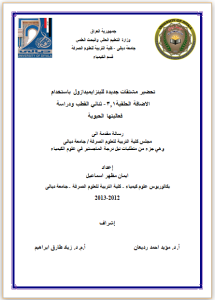Abstract
The current study aimed to conduct a general examination of urine samples, the effect of age and gender on urinary tract infection rate, isolation and molecular identification of klebsiella pneumonia from UTI and study the histopathological changes of bladder and kidney in slaughtered cattle. The study was conducted from the first of September 2023 – to the last of December 2023, collecting 100 urine samples (50 from breeders and 50 from cattle) from different ages, genders, and regions.
A total of 28 (56%) of urine specimens were positive urine culture among breeders and 44 (88%) among cattle. Breeders and cattle infected with Klebsiella pneumoniae had abnormal urine results in terms of physical and biochemical parameters.
Relation of gender with infection rate shows a higher infection rate in females than in males. Cattle show higher morbidity rate with klebsiella pneumonia in the age group 2-4 year while lower morbidity rate were found in the age group more than 4years, while breeders showed higher morbidity rate with klebsiella pneumonia in the age group ( more than 55) while lower morbidity rate were found in the other groups .
Distribution of urinary tract infection caused by Klebsiella pneumonia with the regions of the study shows significant difference region and high morbidity rate were found in Baquba while lower morbidity rate rate were found in Kanaan in breeders and cattle .
Klebsiella pneumoniae isolates were diagnosed molecularly using polymerase chain reaction, depending on the use of specific primers for 16s rRNA, confirming the result of the biochemical tests and VITEK 2 system.
The phylogenetic tree and molecular evolutionary genetics analysis for Klebsiella pneumoniae showed distinct convergence between the local bacterial isolates and the other isolates of countries found in the genetic tree .
In histopathological examination, the kidney in slaughtered cattle showed granuloma (lymphocytes and macrophages), tubules damage, edema, inflammatory cells infiltration, fibrosis, and hemorrhage. In the bladder, there was a thickening of the mucosa, edema, sloughing, fibrosis, and the inflammatory cells infiltration.




